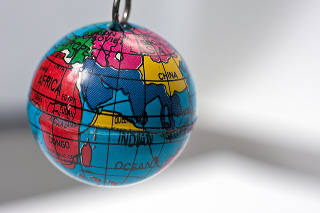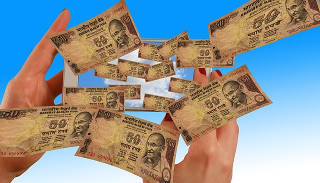[From Pixabay.com]
“In times of change, learners inherit the Earth, while the learned find themselves beautifully equipped to deal with a world that no longer exists.” – Eric Hoffer
In 2019, India will cross these milestones: Half a billion internet users, 100 million internet consumers, over 300 million habitual video-on-phone watchers. India is arguably the largest mobile data consumer in the world, having grown the user base 100X over the year 2000. While the country builds its physical infrastructure at a snail’s pace, digital infrastructure is going through an unprecedented shift.
The triad of near-free bandwidth, super-cheap smartphones, and ubiquitous micropayments—together with a shift away from savings to consumption driven by the aspirations of consumers—is creating perfect weather conditions for rapid seeding, iteration and validation of business ideas in categories that one couldn’t have imagined two years ago. These socio-economic dynamics haven't come together at the same time anywhere in the world. The new digital landscape offers easy access to millions of value-driven consumers, hungry for a better life and willing to try anything. Businesses just need to find a way to serve them.
Welcome to the third wave of the internet in India.
Our market is coming of age. We’ll still remain a fraction of China in spend per user (we’ll probably take a decade to hit where China is today, and catching up may take two decades), but that’s fine. It’ll pave the way for a shift in the economic narrative of the nation. Startups will grow like weeds, propelled by the sudden influx of angel money as first-generation founders put their winnings back into the market. Of course, the death rate of startups will continue to be high, but that’s par for course.
My generation (which entered the workforce in the early 1990s) is probably the most blessed—we are witnesses to the second transformation of our nation. The first in the early 1990s and now once again as we behold the digital transformation of India. Will India ever go through any shift without hiccups? No, it won’t. As long as we base our expectations on the past, we can be optimistic and look forward to a better future.
So, as we live through this once-in-a-generation shift, the market is fecund—it will be the playing ground for mini-revolutions in sectors, trends, ideas and businesses that will rival the US and China, maybe not in size, but in the variety of ideas. There are just too many of these micro-shifts—some obvious and some beneath the surface—that are all firing away at the same time. They affect retail, consumption, jobs and growth in several sectors. I have culled out some key ones I observe. Feel free to add to this list in the comments here or join the thread #Trends2019 on Twitter. I’ll recompile the prominent ones and put them up here. Let’s go.
1. Telecom Tangles
The telcos are the fuel to India’s digital leap and we’ll see a change in the pecking order. Vodafone and Idea are beating a retreat, leaving the field to Jio and Airtel. Bandwidth costs have dropped by over 90% since the launch of Jio. Continuing low average revenue per user (ARPU) is forcing the players to make a shift—to find money outside the sale of bandwidth and low-priced WhatsApp phones. Jio is far ahead in the game here, building content and commerce ecosystems rapidly around its telco flywheel. Its existing media and retail assets provide it significant leverage and if used well can be a lethal combination, and will soon be a threat to both Flipkart and Amazon too.
Airtel has to play catch-up desperately—including resurrecting its half-hearted attempts at growing wired broadband. With the acquisition of Den and Hathway, Jio has the wired market tied up neatly. Now it’s just execution (we've seen what it can do with the near-flawless Jio blitzkrieg). 2019 will be the year it will pull away from Airtel in more ways than just the subscriber count. Will Bharti Airtel fight back or will it be a walkover?
2. The Beginning of the End for TV?
Broadcasters are headed to be collateral damage in India’s digital leap. The Telecom Regulatory Authority of India’s new tariff order will allow viewers to pay for only the channels they watch. This will derail the subscription revenue derived from the channel bouquets, effectively killing the less popular channels in the pack. YouTube and blockbuster content on streaming services (Prime Video, Netflix, Hotstar and others), is pushing TV soaps into slow irrelevance and will take away viewership. Youngsters don’t want to negotiate for the remote anymore. They are done watching saas-bahu soaps; Sacred Games is more their fodder. Broadcasters will grow, but the growth will slow. 2019 will mark the beginning of a reset in the sector that will play out over the next decade.
In India, the smartphone isn’t eating television. It is the television
Indians are spending over 3-4 hours a day glued to their smartphones and the entire edifice of family viewing on which broadcasters’ ad revenues are built is crumbling. We can already see stress on sports rights at Star, and Zee is attempting to induct a partner. In India, the smartphone isn’t eating television. It is the television.
Triple play, a two-decade-old idea, is being resurrected in India—phone, cable, and internet will all come from one provider. This leaves DTH players with nowhere to go. Netflix too will drop its price to gain market: the market in India is inverted—the cable bundle here costs far less than streaming services, unlike in the US where cable is near $100 a month and Netflix averages $12. Netflix will bring down the price when it has some bulk of content with mass appeal.
3. Walmart’s Honeymoon Ends
Every marketer is taught the concept of post-purchase dissonance. Well, Walmart’s global team is in for a shock, as the differences between the DNA of Walmart and Flipkart will surface. The cracks will be visible soon as we witness large-scale restructuring at Flipkart, as Walmart tightens the belt and settles for a long-drawn battle. Walmart’s genetic code is frugality; Flipkart’s code is grow at all costs. Clash is inevitable.
Walmart’s genetic code is frugality; Flipkart’s code is grow at all costs. Clash is inevitable
Walmart has also woken up a giant. Amazon has strung up a minefield of offline partnerships (More, Spencers, Shoppers Stop and the in-the-works Future Group deal). If Amazon can successfully layer Prime, Pay and Now over this hybrid offline-online network, it will give Walmart nightmares. Read my piece on the blueprint of the battle between Walmart and Amazon, where I have talked about what it will take to win India. Tech media should now start scratching beyond the GMV-led PR pieces and do some digging on what people buy, how often and from which player. The picture is dramatically different than the one we read in the pink papers. Ask your neighbour and you’ll anecdotally know what I mean.

[By Horia Varlan under Creative Commons]
4. Privacy Lost
The war between nations won’t be over who has how many steel plants, but over how much control we have over our data
While we were caught in a battle unto death over Aadhaar, a second, bigger threat has been making its way silently into our lives. Chinese smartphones now have commanding market share, and China-built apps have access to all our data. The war between nations will not be over who has how many steel plants or airports, but over how much control we have over our data and how government can encourage the development of technology ecosystems.
It will be crucial for the country to formulate a data protection law which has harsh safeguards against weaponisation of our data by a foreign power. Maybe we need the shock of a massive data breach to get us out of our slumber. The best minds in India need to work on securing our nation, as much as our political parties need brilliant minds to help them win votes.
5. Revive Aadhaar
2019 could be the year we revive and build Aadhar 2.0 which is designed to empower our citizens without compromising their privacy. I remain optimistic that sensible trade-offs can be made. Public digital infrastructure like IndiaStack, the ecosystem of applications around Aadhaar (UPI, eKYC, digital locker, etc), is something we sorely need.
Aadhaar needs to make a comeback and 2019 won’t be soon enough. I wrote about the trade-offs we need to think about in The Thinking Indians’ Guide to Aadhaar, where I argued that stakeholders collectively, unwittingly conspired to destroy a platform that could leapfrog Indian citizens into a digital future. #ReviveAadhar needs to become a movement and we have to collectively undo the damage we have done. It’s an idea whose time has come—and leaving it frozen in time, hostage to a court order, is a travesty.
6. Regional Language Voice and Video
The way to the India Two (the 400-odd million Indians earning an average Rs 7,000 a month) and India Three (the 650 million who barely subsist) consumers’ heart will be via their local languages. Via video. Indians have too much time on their hands—served by the looming unemployment, and waiting for buses and trains, and sitting at the till in tiny shops. The smartphone is our escape route. It is replacing the role the David Dhawan-Govinda movies played. You can see shopkeepers and autorickshaw drivers on video calls with their sweethearts back home in the village. The smartphone is not a device anymore, it’s an extension of their life, a connection with their world, their families as they struggle with the lived realities in our unequal society. They want. No, they demand that they be served where they are, in the language and medium they are comfortable with.
We are a thousand nations in one, and technology will truly allow Indians to be connected to their own
We’ll see a take-off in local-language social networks, video services and news networks. Thinly monetised, but widely spread. We’ll see a thousand Bhojpuri stars. Your personal content consumption basket will probably have a minuscule overlap with a kirana owner in Jodhpur. Each of us will craft our own content worlds. This content will have context they identify with. It will be earthy and it’ll hook them. We are a thousand nations in one, and technology will truly allow Indians to be connected to their own. In the next decade, some of the most valuable businesses will come of this market. It’ll be a mix of advertising and micro-subscriptions, and it’ll be huge.
2019 will signal the birth of massive user-generated regional content. Traditional single stream radio will lose relevance slowly—someone needs to make an app that’s as easy to use as a vintage radio and plays like one. The masses will lap it up. Just like we lapped up the Carvaan from Saregama and gifted it to our elders (over 900,000 units sold and counting).
7. Sitting Ducks
Building a digital mindset is not about launching an app or putting up a website
Traditional businesses will be sitting ducks. Their DNA is not digital and they start with a handicap—building a digital mindset is not about launching an app or putting up a website. It’s about creating a digital avatar, reframing the customer journey and reworking internal processes. It’s even more painful to implement change when you are running a successful company. The legacy mindset conspires to make digital initiatives fail.
It’ll be further compounded by a talent crisis, making it even harder to bridge the digital divide. They simply won’t be able to hire the right people. The best and brightest will join startups or take jobs at our IT giants who are fast transmogrifying their offerings to SMAC (social, mobile, analytics and cloud) services for survival. And the final nail in the coffin will be the wall of capital that will flow into disruptive startups in every sector. Funding will follow the friction. Increasingly I am seeing domain specialists leave well-paying jobs to start up—and those guys know where to attack. Some traditional companies will have the foresight to acquire or acqui-hire startups and they will have a better chance at thriving.
8. Bankers’ Myopia
Three years ago I wrote Honey I Shrunk Your Bank Branch and I spoke to a few bankers on how to undertake digital transformation. Not much has changed. The gap between the bank and the fin-tech players is actually widening. The big bank chief technology officer remains the most difficult person for a startup to get an appointment with, notwithstanding all the accelerators their chief executives sponsor. Bankers will continue to hide behind the regulatory umbrella that the Reserve Bank of India is happy to provide. The overhang of the banking crisis will ensure that bankers keep pushing their customers into the arms of the fintech companies and better-run non banking financial companies (read Bajaj Finserv).
Fintech players will learn that real scaling is not just lending more, but collecting back on the loans
Fintech players will learn this year that the real scaling is not just lending more, but collecting back on the loans. I see massive equity flows into the sector. The existing wallets will either become the fulcrum around which money will be made by selling other services (much like the telcos flywheel example above), or they will get consolidated out of the market.
The sachet-isation of financial services is underway and will gather momentum in 2019. We’ll see ubiquitous micro insurance, instant loans and EMIs with schemes designed around data and convenience. We’ll see growth of wealth management and robo advisory. This will further fuel a consumer wave.
9. Bollywood Redux
Netflix and Amazon Prime have shone the light on the inefficiencies of Bollywood. They are teaching new tricks to the old dogs. Sacred Games—its sheer size, scale and styling—has caused a shift in perspective. Anyone who has seen how different the Tamil industry operates vis-à-vis Bollywood will understand the colossal waste of effort and money that making a movie here entails. Scripting, planning, shooting will get streamlined and we’ll see some incredible global quality output from the same makers and this will find its way into films.
2019 will be the year of the script writer—the forgotten heroes behind many a successful hit. Many spent their best years writing silly soaps for TV. Now they will unleash new ideas and new themes. Looking back a decade from now, you’ll wonder how you watched that content.
10. The Big Whopper
The scorching pace of growth in food-tech will fire up even more. The way the quick service restaurants (QSRs) won in America will repeat in India. Players will roll out cloud kitchens and craft meals that are cheaper (considering time and effort) than home cooking. Indian everyday food is complex to cook and requires planning and labour. Frozen or chilled meals don’t really work for our sabjis, rotis, dosas, or biryanis—our food is multi-layered and won’t survive a blast freeze without losing texture and colour. And there is only so much Western or Chinese food one can have. Inexpensive, hot, home-style Indian food at a great price will ignite the food-tech market. We’ll see unprecedented scale—carrying lunch to work will become a thing of the past and working adults will get their dinners from cloud kitchens. 2019 will see a massive shift in our eating habits.
11. Indians Go Lazy
Indians will get even lazier. Why step out when the Air Quality Index is hazardous and traffic is abominable? Click or simply speak into your phone and voila! the doorbell rings in 20 minutes. I had predicted that India will become a country of cabs and courier boys in my piece Making Money off the Lazy Economy in 2015. And look at our streets now—it’s coming true!
Offline-to-online (O2O) will mature and the smarter retailers will recraft their store footprints. With food-tech defraying the peak-time delivery cost, delivering in off-peak will become extremely affordable. The toughest market in the world for groceries is India. The assortment of daily needs in Mumbai’s Matunga area is very different from Mahalaxmi. No amount of central inventory management will work. It simply can’t—the perishables will perish. We’ll see some incredible innovation. Whoever puts together a platform to bring retailers together—whether it’s Dunzo, Reliance, or Grofers—and whoever finds a way to create really concentrated hyperlocal delivery ecosystems will win.
12. Game On
In 2009 when I was running MTV, I had seeded an idea of an app called “Vela” (free time). A consumer could spend a few minutes playing a simple game with a server, and each time it would serve up a new game or puzzle. That was much ahead of its time. And it looked like we had missed the bus in gaming when it exploded in the US and China a few years ago. The conditions are now perfect—Fantasy Cricket is already big and simple mobile games designed to resonate with our masses with tiny amounts at stake will take off. If you are invested in a mobile gaming startup, that’s a keeper.

[From Pixabay.com]
13. India One, Two, and Three
I wrote about the yawning gap between India’s promised and actual internet consumers in this much cited piece. Guess now it’s time to stop debating about the size of these segments, and simply build offerings that can be bundled and un-bundled depending on who the customer is. The edges of each of these segments is blurred, and the India Two customer who may never buy groceries and clothes on ecommerce may buy their Rs 20,000 smartphone and spend a few hundred rupees a month playing mobile games.
In a heterogeneous market like ours, a safer strategy is to allow consumers to reveal their preferences to you
The power of the internet to address each customer as one will have to be unleashed—Zomato should be able to serve you the finest gourmet sushi with dinner for two costing Rs 1,500, and also serve me and my colleagues in an SME business a lunch for two for Rs 150. With the fuzziness in consumer behaviour that we see in a heterogeneous market like ours, a safer strategy is to offer the choices to consumers and allow them to reveal their preferences to you. The internet makes that possible. It cuts the risk of experimentation and allows for rapid iteration—something that large, traditional players cannot do.
14. Bye HUL, Hello Mamaearth
FMCG brands will start feeling the pinch. The markets have been easy. Their massive distribution infrastructure and widespread sales teams were their moats. In bad years, they sacrificed margins for market share and grew their business; in good years the rising tide grew their business. But now is the time for the challengers who can sell direct to consumers—why spend money on the chain when they can use the money to establish a direct link with the customer? Why get bound by modern retailers who suck away up to 40% of your revenue and make listing your product and managing shelf space hell? Let’s go direct!
The incumbents don’t get ecommerce. Most have abrogated their thinking to outside agencies and distribution agents. At 3-5% of their revenues, online is too small a revenue stream to dedicate their expensive overheads too. The challengers, of course, work hard. Aided by the easy listing on Amazon, they will work harder, make products that target the audience better, and build loyalty.
For a country that’s so starved of brands, this ability to segment audiences and serve them has started to work. Setting up an online store is now off the shelf and teams can dedicate time to researching and targeting and creating narratives. The big boys are fast running out of stories to tell and have zero engagement with their end customers. They are happy spending time and energy talking to retailers.
We’ll see the first scaled hundred crore run rate direct-to-consumer brands. These brands will build their salience and franchise online, and then find a way to enter offline. Money will follow these companies—initially in health and wellness, and cosmetics as they are high-margin businesses, and then virtually every underserved segment of the market. The big boys will have no choice but to acquire—their DNA neither allows for the new age narratives nor the constant engagement. If you want to read why they will struggle to fight this battle, read this.
15. Psychology and Social Effects
The smartphone is the new opium of the masses. It’s redefining how we connect with each other and the world. For some it’s a vehicle for escape, for others a tool for business. What’s clear is that Indians are taking to these shifts like fish to water—if anything, these devices are cementing connections and making people more secure and confident.
Traditional marketers thought of the Indian family as one unit, but that monolithic framework has to change—each individual is a potential influencer and a target segment and can be reached in different contexts and with different messages. Studying the millennial and understanding the consumer will become the key to winning. For tech startups, product experience is God, the rest is merely code.
I am sure I’ve missed many trends. We’ll probably have a global player acquire one of large Software as a Service (SaaS) players. The ed-tech segment will throw up some blockbuster winners and SoftBank will probably commit much more than its promised $10 billion. Times Internet is doing some interesting work quietly and it’ll be a player to watch. I hope some startups will crack the code to rework the supply and information chains in India that keep our farmers poor despite the fact that we pay sky-high prices for fresh groceries at the store next door. Successive governments have abysmally failed at doing this—we are a rich nation, that they love to keep poor!
One thing is for sure: 2019 will be more unpredictable. The tussle between Donald Trump and China can cause us collateral damage. And we should pray that we don’t have a 2008-style global financial crisis again.
A final word for the big event of 2019—the general elections. We’ll see the dirtiest battle in the history of Indian politics. Every piece of ignorance and bigotry will be used by all sides in this game. The smartphone will become the centrepiece of the battle. Voter databases, WhatsApp group implants and data analytics will define who wins—privacy issues be damned! So vote thoughtfully—you don’t have much to choose from.
May you march forth into uncertainty and opportunity with confidence. Have a great 2019.
PS: Join me in being a trend spotter and add to #Trends2019. I’ll be happy to pick some and expand this list.


